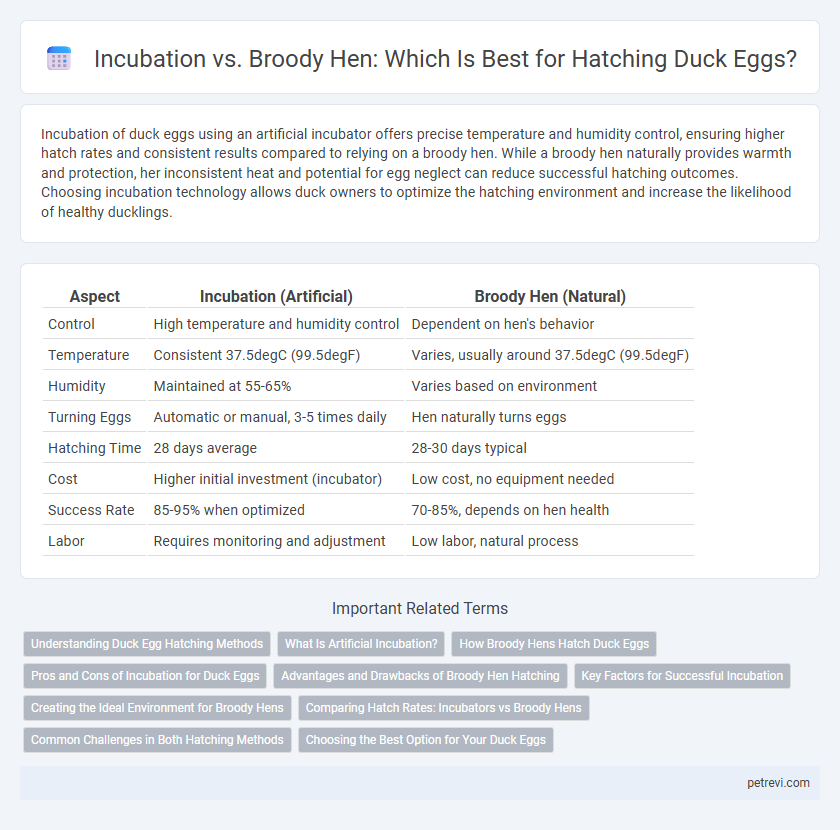Incubation of duck eggs using an artificial incubator offers precise temperature and humidity control, ensuring higher hatch rates and consistent results compared to relying on a broody hen. While a broody hen naturally provides warmth and protection, her inconsistent heat and potential for egg neglect can reduce successful hatching outcomes. Choosing incubation technology allows duck owners to optimize the hatching environment and increase the likelihood of healthy ducklings.
Table of Comparison
| Aspect | Incubation (Artificial) | Broody Hen (Natural) |
|---|---|---|
| Control | High temperature and humidity control | Dependent on hen's behavior |
| Temperature | Consistent 37.5degC (99.5degF) | Varies, usually around 37.5degC (99.5degF) |
| Humidity | Maintained at 55-65% | Varies based on environment |
| Turning Eggs | Automatic or manual, 3-5 times daily | Hen naturally turns eggs |
| Hatching Time | 28 days average | 28-30 days typical |
| Cost | Higher initial investment (incubator) | Low cost, no equipment needed |
| Success Rate | 85-95% when optimized | 70-85%, depends on hen health |
| Labor | Requires monitoring and adjustment | Low labor, natural process |
Understanding Duck Egg Hatching Methods
Duck egg hatching methods primarily involve incubation and broody hens, each with distinct advantages. Artificial incubation offers precise temperature and humidity control, typically maintaining 99.5degF and 55-65% humidity for optimal embryo development during the 28-day incubation period. Broody hens provide natural warmth and turning but require careful management to ensure consistent conditions and successful duckling hatch rates.
What Is Artificial Incubation?
Artificial incubation involves using controlled environmental conditions such as temperature, humidity, and ventilation to hatch duck eggs without the need for a broody hen. This method enables precise regulation of the incubation period, typically 28 days for duck eggs, enhancing hatch rates and reducing risks associated with natural broody hens like inconsistent warmth or abandonment. Hatcheries and duck farmers commonly rely on incubators to increase efficiency and predictability in duck egg hatching.
How Broody Hens Hatch Duck Eggs
Broody hens hatch duck eggs by instinctively sitting on them to provide consistent warmth and humidity, essential for embryo development during the 28-day incubation period. Their natural body heat maintains the optimal temperature of around 99-102degF (37-39degC) and humidity levels near 55-65%, while their periodic turning of the eggs prevents embryo adhesion and promotes uniform growth. This biological process offers a reliable, low-cost alternative to artificial incubation machines, enhancing hatch rates through maternal care and environmental regulation.
Pros and Cons of Incubation for Duck Eggs
Incubation for duck egg hatching allows precise control over temperature and humidity, significantly increasing hatch rates and reducing the risk of egg damage or predation. However, it requires specialized equipment, constant monitoring, and energy input, which can be costly and time-consuming compared to relying on a broody hen. Although incubation provides consistent environmental conditions, it lacks the natural turning and warmth adjustments a broody hen offers, potentially impacting chick vitality if not carefully managed.
Advantages and Drawbacks of Broody Hen Hatching
Broody hen hatching offers natural warmth and consistent incubation conditions, promoting higher hatchling survival rates and stronger ducklings due to natural turning and humidity control. However, drawbacks include the hen's potential neglect of eggs, susceptibility to predators, and limited ability to maintain ideal temperatures compared to artificial incubators. This method also restricts the number of eggs hatched simultaneously and may prolong the incubation period depending on the hen's behavior and environment.
Key Factors for Successful Incubation
Successful incubation of duck eggs requires maintaining a consistent temperature of 99.5degF (37.5degC) and humidity levels around 55-60% during the initial 25 days, increasing to 65-70% in the last three days before hatching. Turning the eggs at least three times daily prevents embryo adhesion and promotes even development, a task naturally performed by broody hens but requiring careful manual management in incubators. Proper ventilation and candling to monitor embryo growth are essential to detect infertile or dead eggs, ensuring optimal hatch rates.
Creating the Ideal Environment for Broody Hens
Creating the ideal environment for broody hens involves maintaining consistent warmth around 99degF (37.2degC) and proper humidity levels near 55-65% to ensure successful duck egg incubation. Providing a quiet, draft-free nesting area with soft bedding encourages hens to remain broody and reduces stress, which can negatively impact hatching rates. Adequate nutrition and access to water are essential to support the hen's health during the incubation period, typically lasting 28 days for duck eggs.
Comparing Hatch Rates: Incubators vs Broody Hens
Incubators typically achieve higher and more consistent hatch rates for duck eggs, averaging around 75-85%, due to precise control over temperature and humidity. Broody hens exhibit variable success, often ranging from 50-70%, as their ability to maintain ideal conditions depends on breed, experience, and environmental factors. Controlled incubation reduces risks of egg damage and temperature fluctuations, making incubators more reliable for maximizing hatch success in duck egg cultivation.
Common Challenges in Both Hatching Methods
Duck egg incubation faces common challenges such as maintaining precise temperature and humidity levels, which are essential to prevent embryo mortality and deformities. Both incubators and broody hens struggle with the risk of fungal infections and bacterial contamination due to inadequate ventilation or prolonged dampness. Consistent turning of eggs is critical in both methods to avoid improper embryo development and increase hatch rates.
Choosing the Best Option for Your Duck Eggs
Choosing between incubation and a broody hen for duck egg hatching depends on control and success rates; artificial incubators offer precise temperature and humidity regulation for consistent results, while broody hens provide natural warmth and instinctive care, reducing equipment costs. Incubation requires monitoring systems to maintain ideal conditions, increasing hatch rates up to 85-90%, whereas broody hens vary in reliability based on breed and maternal behavior. For maximizing survival and healthy ducklings, incubation is preferred in commercial settings, while broody hens suit small flocks with attentive caretakers.
Incubation vs Broody hen for Duck egg hatching Infographic

 petrevi.com
petrevi.com